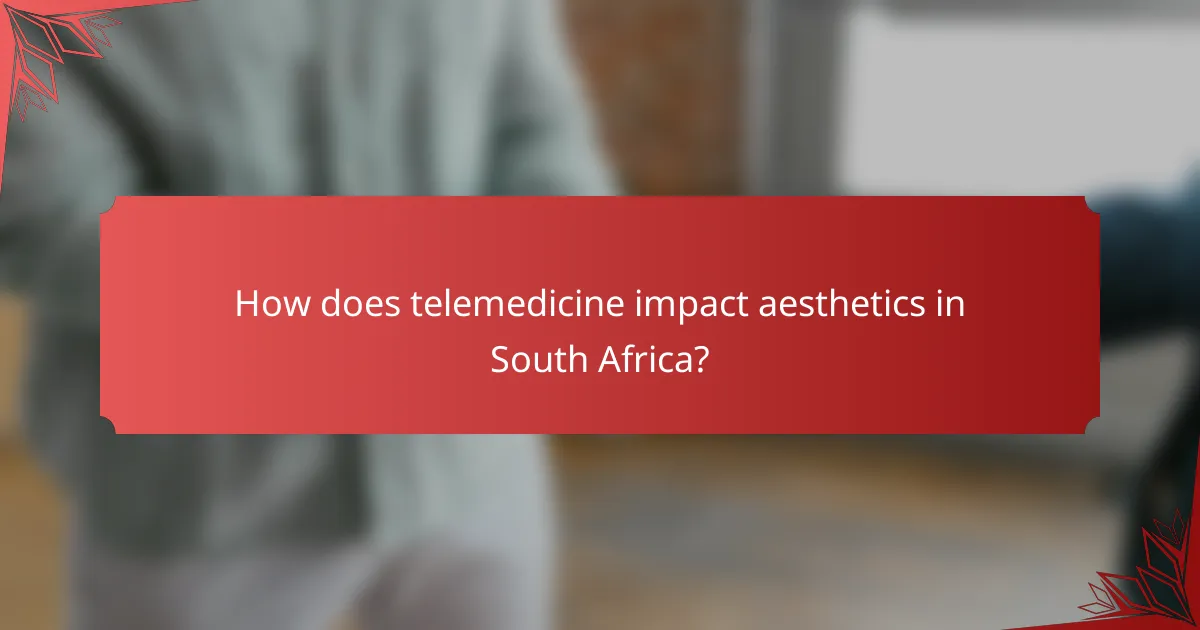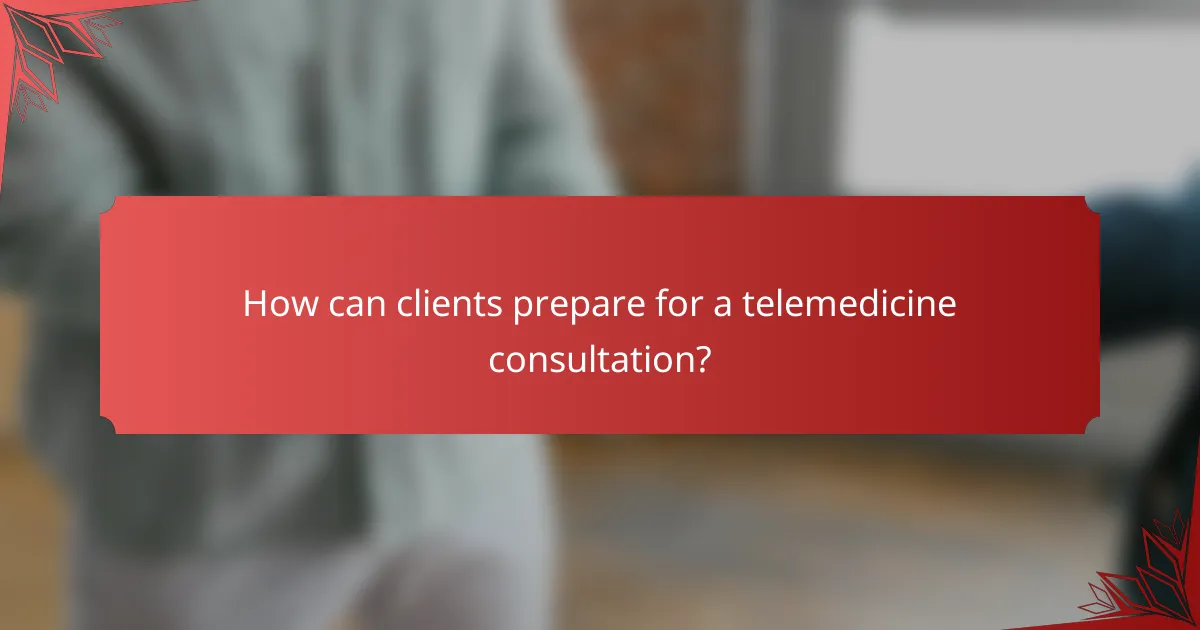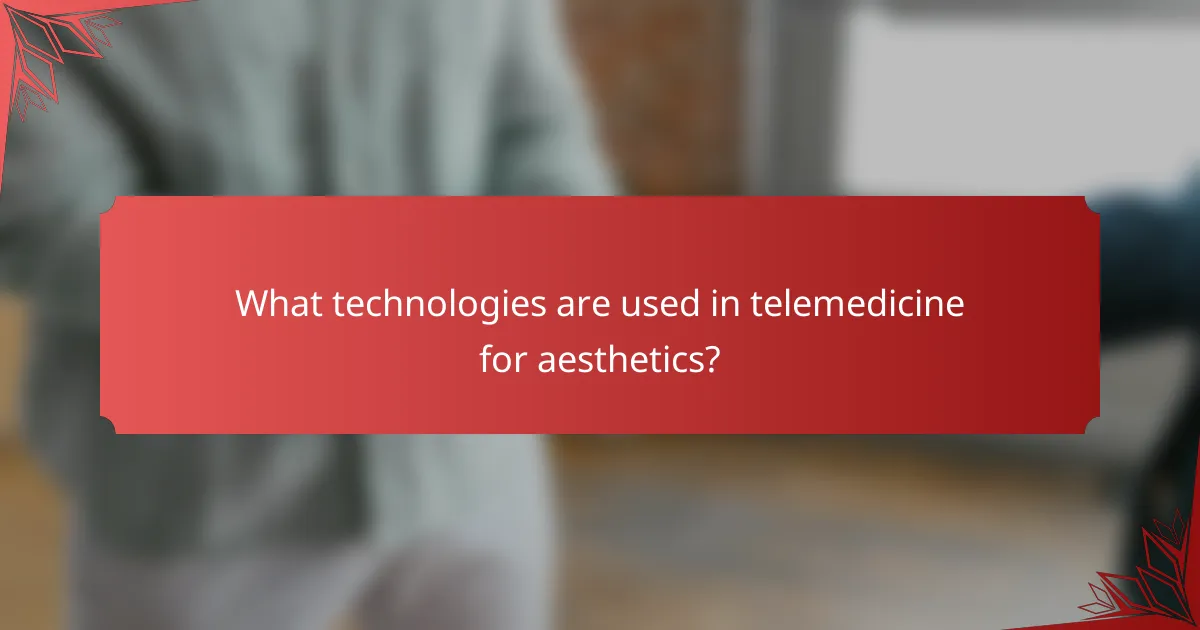Telemedicine is revolutionizing the aesthetics industry by offering clients convenient access to consultations and treatments from the comfort of their homes. This innovative approach not only enhances accessibility but also allows for personalized care tailored to individual needs. By preparing adequately for virtual appointments, clients can maximize their experience and receive expert guidance without the necessity of in-person visits.

How does telemedicine impact aesthetics in South Africa?
Telemedicine significantly enhances the aesthetics industry in South Africa by providing remote access to consultations and treatments. This approach allows clients to receive aesthetic care without the need for in-person visits, making it more convenient and efficient.
Increased accessibility to aesthetic treatments
Telemedicine improves accessibility to aesthetic treatments by allowing clients in remote areas to connect with qualified practitioners. This means individuals who previously faced barriers due to distance or mobility can now access services that were once limited to urban centers.
For example, a client in a rural area can schedule a virtual consultation with a dermatologist in Johannesburg, eliminating travel costs and time. This increased access can lead to a higher number of clients seeking aesthetic services.
Cost-effectiveness for clients
Utilizing telemedicine can be more cost-effective for clients seeking aesthetic treatments. Remote consultations often have lower fees compared to in-person visits, and clients save on travel expenses.
Additionally, many practitioners offer flexible payment options for telemedicine services, making it easier for clients to manage their budgets. This financial accessibility can encourage more individuals to pursue aesthetic enhancements.
Enhanced patient engagement
Telemedicine fosters enhanced patient engagement by allowing clients to communicate more freely with their practitioners. Clients can ask questions and express concerns in a comfortable environment, leading to better understanding and satisfaction with their treatment plans.
Regular virtual check-ins can also help practitioners monitor client progress and adjust treatments as needed, creating a more personalized experience that encourages ongoing participation in their aesthetic journey.
Improved follow-up care
Follow-up care is streamlined through telemedicine, allowing clients to easily connect with their practitioners after treatments. This can include discussing results, addressing side effects, or planning future procedures.
Practitioners can schedule quick virtual appointments to assess healing or satisfaction, ensuring that clients feel supported throughout their aesthetic experience. This ongoing care can lead to better outcomes and higher client retention rates.
Broader range of services available
Telemedicine expands the range of aesthetic services available to clients. Many practitioners now offer virtual consultations for various treatments, including skin assessments, product recommendations, and even follow-up care for procedures like injectables.
This broader service offering allows clients to explore options they may not have considered otherwise, increasing their awareness and interest in aesthetic treatments. As telemedicine continues to evolve, more innovative services are likely to emerge, further enhancing client choices.

What are the benefits of telemedicine in aesthetic procedures?
Telemedicine in aesthetic procedures offers numerous advantages, including enhanced accessibility, tailored treatment options, and improved client experience. By leveraging technology, clients can receive expert consultations and personalized care from the comfort of their homes.
Convenience of remote consultations
Remote consultations allow clients to connect with aesthetic professionals without the need for in-person visits. This convenience enables individuals to schedule appointments at times that fit their busy lifestyles, often leading to quicker access to care.
Clients can discuss their concerns and treatment options through video calls, making it easier to receive expert advice without the hassle of travel. This flexibility is particularly beneficial for those living in remote areas or with mobility challenges.
Personalized treatment plans
Telemedicine facilitates the creation of customized treatment plans tailored to each client’s unique needs. During virtual consultations, practitioners can assess individual goals and preferences, leading to more effective and satisfying outcomes.
Clients can share images and detailed descriptions of their concerns, allowing professionals to recommend specific procedures or products that align with their aesthetic aspirations. This personalized approach can enhance client satisfaction and improve treatment success rates.
Reduced travel time and costs
By utilizing telemedicine, clients can significantly reduce travel time and associated costs, such as fuel or public transport fares. This is especially advantageous for those who may need to travel long distances to access quality aesthetic care.
Additionally, the elimination of travel can lead to more frequent consultations, allowing for timely adjustments to treatment plans without the burden of logistical challenges.
Privacy and comfort for clients
Telemedicine provides an added layer of privacy and comfort for clients seeking aesthetic procedures. Many individuals may feel self-conscious about discussing their concerns in a physical clinic setting, but virtual consultations can alleviate this discomfort.
Clients can engage in discussions about sensitive topics from their own homes, fostering a more relaxed atmosphere. This comfort can lead to more open communication and better understanding between clients and practitioners, ultimately enhancing the overall experience.

How can clients prepare for a telemedicine consultation?
Clients can prepare for a telemedicine consultation by organizing relevant medical information and ensuring they have a reliable internet connection. This preparation helps facilitate a smooth and effective virtual appointment with their aesthetic practitioner.
Gather medical history and documents
Clients should compile their medical history, including any previous treatments, allergies, and current medications. This information is crucial for the practitioner to assess suitability for aesthetic procedures.
Additionally, having documents like prior treatment records or photographs can provide valuable context during the consultation. Clients may want to create a digital folder to easily share these files during the appointment.
Prepare questions for the practitioner
Clients should write down any questions they have regarding the procedure, recovery, and expected outcomes. This ensures they cover all their concerns during the consultation.
Common questions might include inquiries about the risks, costs, and alternative treatments. Having these questions ready can help clients feel more confident and informed during their telemedicine session.
Ensure a stable internet connection
A stable internet connection is essential for a successful telemedicine consultation. Clients should test their connection beforehand to avoid disruptions during the appointment.
Using a wired connection or being close to the Wi-Fi router can enhance stability. If possible, clients should choose a quiet, well-lit space for the consultation to minimize distractions and improve communication with the practitioner.

What technologies are used in telemedicine for aesthetics?
Telemedicine in aesthetics utilizes various technologies to enhance client consultations and treatments. Key tools include video conferencing platforms, mobile apps for virtual consultations, and AI-driven diagnostic tools that streamline the process and improve client outcomes.
Video conferencing platforms like Zoom
Video conferencing platforms, such as Zoom, facilitate real-time consultations between clients and aesthetic practitioners. These platforms allow for face-to-face interactions, enabling professionals to assess client needs visually and provide personalized recommendations.
When using video conferencing, ensure a stable internet connection and good lighting to enhance visibility. Practitioners should also consider privacy regulations, such as HIPAA in the U.S., to protect client information during virtual meetings.
Mobile apps for virtual consultations
Mobile apps designed for virtual consultations provide an accessible way for clients to connect with aesthetic professionals. These apps often include features like appointment scheduling, secure messaging, and photo sharing, which help streamline the consultation process.
Clients should look for apps that prioritize user-friendly interfaces and data security. It’s beneficial to check if the app complies with local regulations regarding telemedicine and client data protection.
AI-driven diagnostic tools
AI-driven diagnostic tools analyze client images to assess skin conditions and recommend treatments. These tools can provide insights based on machine learning algorithms, helping practitioners make informed decisions about aesthetic procedures.
While AI tools can enhance diagnostic accuracy, they should complement, not replace, professional judgment. Clients should be aware that results may vary, and it’s essential to consult with a qualified practitioner for personalized advice based on AI assessments.

What are the legal considerations for telemedicine in aesthetics?
Legal considerations for telemedicine in aesthetics include licensing requirements, patient consent, and adherence to privacy regulations. Practitioners must ensure they are licensed in the state where the patient resides and comply with local laws governing telehealth services.
Licensing requirements
Practitioners offering telemedicine services in aesthetics must be licensed in the state where the patient is located. This often means obtaining a specific telemedicine license or ensuring that their existing medical license covers telehealth practices. It’s crucial to verify state-specific regulations as they can vary significantly.
Patient consent
Informed consent is essential in telemedicine, particularly in aesthetics where procedures may involve risks. Practitioners should provide clear information about the treatment, including potential outcomes and risks, and obtain written consent from the patient before proceeding. This protects both the patient and the provider legally.
Privacy regulations
Compliance with privacy regulations, such as HIPAA in the United States, is critical for telemedicine in aesthetics. Practitioners must ensure that all patient information is securely transmitted and stored. Using encrypted platforms for video consultations and secure methods for sharing documents can help maintain confidentiality.
